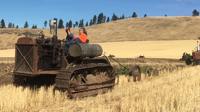- Posts: 110
- Thank you received: 0

ACMOC Membership Benefits
- FREE quarterly magazine filled with content about antique Caterpillar machines
- FREE classified listings
- ACMOC store discounts and specials
- Full Bulletin Board Access
- Marketplace (For Sale/Wanted)
- Technical Library
- Post attachments
$44 /year ELECTRONIC
$60 /year USA
$77 /year International
(pictures) farming with steel tracks
Please Log in or Create an account to join the conversation.
I grew up on the wee Emerald island on a nice farm and never experienced that lo of a temp there. Now my roots are well established here in the west with a good bloom on the top end!
Please Log in or Create an account to join the conversation.
Next is a pic from this harvest picking up some flat soft white wheat with the 9400 JD. This feild (same one I subsoiled) went a little over 100 bu wich is pretty darn good for us. Our average this year was 74 bu thanks to a variety called AP700 that only made 42 bu. But over all a very good year.
NIF and 98J very nice pics as always.
Bruce
Please Log in or Create an account to join the conversation.
Bruce
Please Log in or Create an account to join the conversation.
- North Idaho Farmer
-
 Topic Author
Topic Author
- Offline
- Elite Boarder
- User
- Posts: 224
- Thank you received: 0
Please Log in or Create an account to join the conversation.
We had two varietys that did well and one that didn't. The good ones were ORCF 102 and Xerpha both went 100+ in good soil and 80 in the more shallow soil. The crumy one was AP700CL it went alittle over 40 in good soil. We got darn lucky with the Xerpha as it didn't break to stripe rust. This year we had Crop Production Service (Western Farm) do a variety plot so we got some real good data from that. I wish we would have had it before I seeded the AP700, oh well.
Get much snow last night? Ours was almost blown/melted away till yesterday got about 3". I'm sure glad that -11 stuff is over with, at least for now, we had a good 8" blanket of snow on the wheat so that was one less thing to worry about.
Bruce
Please Log in or Create an account to join the conversation.
Please Log in or Create an account to join the conversation.
Bruce
Please Log in or Create an account to join the conversation.
- North Idaho Farmer
-
 Topic Author
Topic Author
- Offline
- Elite Boarder
- User
- Posts: 224
- Thank you received: 0
Our ORCF 102 did very well for us this year as well, the Xerpha got hit by rust big time but still did all right. We planted both those again this fall along with Westbred 528. Lambert has typically been the main wheat we planted for over 10 years but the rust strains have mutated to where Lambert is affected by it.
Please Log in or Create an account to join the conversation.
Cuz Casey and I were discussing the combining of 100 bushel grain, if we harvest a ton of barley that is a great crop(I didn't say it was a money maker just a great crop) we just don't get the rainfall to support big crops. When I was a kid, there was a fellow on the far end of Carrizo Plains here in Central Ca. (very low rainfall) his seeding rate was 18 pounds per acre of old Mexican Hard Red Wheat and if it came up to thick he would take his old Cletrac and 70 feet of harrow and thin it out a bit and would usually harvest a bin a day if he was lucky with a 27 Massey Harris, his grain truck was a Model ''A" Ford with a hand cranked cabled dump bed that would hold two bins, so he had to dump it every other day:lol: ( this was in 1967). 10 bushels vs 100 bushels:confused2: but he didn't have much in it, "1" light disking, seeding, maybe a harrowing and harvesting and Pillsbury would pay top dollar because that area would grow 20% protein wheat and they loved it for baking, at any rate he survived there. That whole area has been "SAVED" from so-called immanent destruction from farming for the Kangaroo Rat and Blunt Nosed Leopard Lizard, Kit Fox, and Antelope Ground Squirrel:censored:. Tad
Please Log in or Create an account to join the conversation.
ACMOC
Antique Caterpillar Machinery Owners Club
1115 Madison St NE # 1117
Salem, OR 97301
support@acmoc.org
"I became a member recently because the wealth of knowledge here is priceless."
- Chris R
"I also joined a year ago. had been on here a couple of times as a non-member and found the info very helpful so I got a one year subscription (not very expensive at all) to try it out. I really like all the resources on here so I just got a three year. I think its a very small price for what you can get out of this site."
- Jason N


